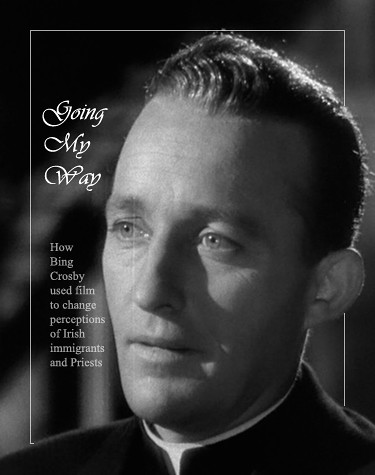
Volume XVI, Issue XVII
An American Story 'Going My Way'
'Father O'Malley' Put a Human Face on Immigrants
'Going My Way' transformed the popular image of Irish Americans and turned the Catholic priest in to a popular hero.
In our time, when President John Fitzgerald Kennedy is considered one of our nation’s foremost leaders, it is hard to imagine that in the years leading up to World War II he might not even have been electable. Prior to Kennedy, Al Smith, four time governor of New York, had attempted a Presidential bid in 1928. Though he had a strong resume as a reformer he lost. He was the first Roman Catholic to run for the office and his defeat was largely due to the prejudices of the day. Bing Crosby would use film as a means to give his fellow Irishmen a human face. His Father O’Malley character showed Americans the true face of urban priests who often worked to win over tough youths and dealt practically with many inner city issues.
Can We Believe?
[click to read]
A personal reflection on why we shouldn’t abandon the faith that has nourished Western civilization by Andrew Klavan. (read more)
A West whose ethicists coolly contemplate infantile euthanasia, whose nations roll back their magnificent jurisprudence to make room for the atrocity of sharia, whose historians argue themselves out of the objective reality of human rights because they have lost faith in the numinous basis of those rights—such a West may not be heading for disaster as much as it is living in the midst of one, a comfortable and prosperous disaster to which our default atheism makes us blind, a dystopia in which we are increasingly happy and increasingly savage at the same time.”

Bee On Dogwood Blossom. Photo by Sandra Barlow Powell.

Volume XVI, Issue XVIIa
Josiah
By Bob Kirchman
Copyright © 2019, The Kirchman Studio, all rights reserved
Chapter 3: Survivors!
Survivors,” Ben-Gurion repeated thoughtfully. “How should we reach them?”
Indeed the presence of survivors presented an obligation to those who pondered it. Simply doing nothing seemed immoral at best but what to do seemed not so cut and dried. An unmanned landing might be best as there would be the ability to send a message without risking more lives. The initial lander could be configured to take back survivors if necessary. “How fast could we prepare a lander mission?” Hannah asked. Theoretically it could be ‘pulled from the shelf’ and launched within the month. It would take nine months to get to Mars. In the event it were necessary, Great Northern could be taken from its defense position and flown with additional landers to evacuate more people.
What if they don’t want to come ‘home?’” Abiyah asked. “Should we be prepared to resupply them?”
That is a good question.” said Hannah. “Since our last contact was aggressive on the colonist’s part, we need to think about this.”
Some of Cape Lisbon Space Center’s best minds were brought to bear to hash out the proper thing to do. There at Cape Lisbon’s linear induction launch canon, they called themselves the “Baltimore Gun Club,” since their device seemed similar to the one Jules Verne first wrote about in From the Earth to the Moon.
It was not a columbiad, as Verne predicted, but rather a linear induction track similar to the high speed transportation system being built to link the world via vacuum tubes. Massive use of fossil fuels was now replaced by electromagnetism. That electromagnetism was produced by tapping the geothermal energy of the earth itself. It was clean, efficient, did nothing to harm the environment and it was cheap!
Some sections of HYPERLOOP between large cities were already in operation and the entire system was going to open by 2059. It was going to usher in new economy in world transportation. The launch canon used the same electromagnetic propulsion as well and it presented the most economical means of sending a craft to Mars.
In the end, a hastily prepared lander was dispatched and flown remotely to the planet’s surface. A ‘rover’ was on board to move about and survey the colony. A message was composed to offer the surviving colonists an olive branch and a radio/video communication device was included. The ‘rover’ carried standard pressure suits and breathing packs. Every effort was made to offer the survivors a remotely piloted ‘ride home.’ The biggest problem was that they had to guess how many there might be.
The unmanned emissary was launched within the month. For nine months the controllers in Cape Lisbon and on SS/AC005 waited.
__________
The lander fired it’s descent engine and arced down to the Martian surface. The engine slowed it as it touched down next to the remains of the Martian colony. The rover was deployed and began its survey of the colony. It approached a door on one of the greenhouses and showed the controllers on Earth a lot of space-booted footprints coming in and out. The rover reduced power and waited.
Discovery was not long in coming. Two figures in space suits emerged from the greenhouse door and seemed to be in quite animated hand-gesture concerning the new ‘visitor.’ In the end they pulled the rover into a bay with a tractor for further examination. The bay was pressurized and the two figures removed their helmets, examining the rover further. They read the message of peace and discovered the camera/radio.
They said nothing loud enough to be heard, however and eventually one of them disappeared for a time. He returned with a third man who deliberately positioned himself in front of the camera and activated the communication device. Controllers on Earth held their breath as he began to speak.
My name is JOSIAH.”
(to be continued)
Renewed Minds and Our Vision of Reality
Dr. Paul Tyson’s lecture explored how the Christian responsibility “to repent” involves more than expressing feelings of regret for moral wrong-doing and the desire to reform. Rather, the New Testament call to “repentance,” the English rendition of the Greek word metanoia, is inseparable from radically reenvisioning what is “really real.” St. Paul’s admonition that we be “transformed by the renewing of our minds” — in other words, metanoia — invokes a process that demands the recognition and rejection of various false enchantments of this world. With the help of C. S. Lewis’s story The Silver Chair, however, we realize that identifying and then escaping the ways in which we are bewitched is no easy task. (read more)
Creation, Modernity, and Public Theology
[click to read]
Many contemporary discussions that make reference to creation are framed in light of assumed conflicts between science and religion and are frequently concerned with giving an account of the earth’s origins. But is talking about origins synonymous with what the church fathers meant by the act of creation? Does providing scientifically plausible accounts of how the earth began or pointing to staggering probabilities as evidence for intelligent design provide an adequate understanding of the relationship between God and creation? Do we as modern Christians truly understand what the church fathers meant by “nothing” in the phrase creation ex nihilo? (read more)
Alison Milbank on Imaginative Apologetics
[click to read]
What I am calling ‘imaginative apologetics’ renews our mind. It begins when we ourselves stand apart from ourselves and receive our faith freshly, as if gifted to us for the first time, and when we use the difference of our religious culture to provoke the secularized person. So much of our missiology tells us to do the opposite — to give the people the familiar . . . to conform to contemporary modes . . . I’m suggesting the opposite: that we make our faith truly strange, first to ourselves and then to those we hope to attract. If someone lives a buffered existence within the fortress of materialism we have to help them question those limits to experience and the real, so that we may show them Christ in his true depth and beauty and strangeness.”
— Alison Milbank
This spring, theologian Alison Milbank presented the fifth Areopagus Lecture. In her talk “Imaginative Apologetics beyond C. S. Lewis,” Milbank offered an approach to defending the Christian faith that restores the imagination as a faculty inseparable from reason. By using C. S. Lewis as a conversation partner — along with Owen Barfield, Samuel Taylor Coleridge, G. K. Chesterton, and Novalis — Milbank explored how the imagination is not just an instrumental means to an objective end, but the ecstatic and receptive means by which we participate in what is True and Real. (read more)
Desiring Heaven

There have been times when I think we do not desire Heaven; but more often I find myself wondering whether, in our heart of hearts, we have ever desired anything else. You may have noticed that the books you really love are bound together by a secret thread. You know very well what is the common quality that makes you love them, though you cannot put it into words: but most of your friends do not see it at all, and often wonder why, liking this, you should also like that. Again, you have stood before some landscape, which seems to embody what you have been looking for all your life; and then turned to the friend at your side who appears to be seeing what you saw—but at the first words a gulf yawns between you, and you realise that this landscape means something totally different to him, that he is pursuing an alien vision and cares nothing for the ineffable suggestion by which you are transported. Even in your hobbies, has there not always been some secret attraction which the others are curiously ignorant of—something, not to be identified with, but always on the verge of breaking through, the smell of cut wood in the workshop or the clap-clap of water against the boat’s side?”
— C. S. Lewis, The Problem with Pain
